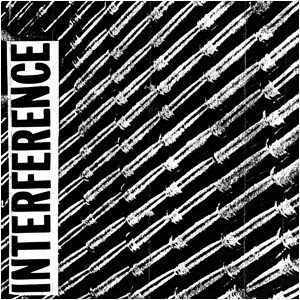
Interference
The Social Registry
Like many of his contemporaries in the avant garde, no wave scene infesting New York’s Lower East Side during the early ’80s, drummer David Linton cut his teeth playing in the various ensembles assembled by luminaries Glenn Branca and Rhys Chatham. His studies in noise and drone continued with former classmate Lee Renaldo in the Fluks and Plus Instruments before he split in 1981 to form his own band, Interference, a group that, unlike so many others from the time, has never received much recognition, even amongst record collector scum—probably because, save for a small amount of self-released cassettes, there was never a release to hunt down.
Joining Linton in Interference were keyboardist Anne DeMarinis, a member of an early version of Sonic Youth (Renaldo ended up taking her place) and a curator of the Noise Fest shows at White Columns with Thurston Moore, and bassist Michael Brown, another alum from the Chatham school and a former Elliot Sharp collaborator. Though it was this line-up that began playing out at places like CBGBs and the Mudd Club, when the time came in 1982 to record their would-be full-length album, the trio was joined by Swans’ Sue Hanel and another Chatham defector, Joe Dizney. Though Hanel left the group before the album was completed, Dizney stayed on, while Elliot Sharp made a guest appearance on the record.
Recorded with Don Hunerberg (Blondie, Sonic Youth, Live Skull), the album was intended for release on Josh Baer and Glenn Branca’s Neutral imprint, but the label ended up reneging at the last minute. As such, the record has never been widely available, and Interference faded into obscurity once they called it quits in 1983. Fortunately, the Social Registry label has seen fit to resurrect the album (digitally and on vinyl), in the process calling on Linton to enlist remixers to work their magic on the album for a second record of material. (Linton immersed himself in the trance circuit after Interference’s demise.)
What’s remarkable and perhaps surprising about Interference, is the caliber of the material. This was not a band of C-class noise-niks, but rather exemplary practitioners working in the same parameters as their contemporaries, but from an entirely different perspective. With Linton’s rhythms—just as likely to be clanked out on some scrap metal and a coat rack as a set of toms—leading the way, the record is soaked in a primordial groove. Leadoff “Excerpt #1 Version 2” shows the band chewing a post-punk jam down to its nub. “She Said Destroy,” one of the only cuts to feature vocals, exhibits playful drones, but worked into a palpable form, like a slice of deconstructed Kraut funk. However, on the closing track, “Number Four,” the group lets loose full-bore in a proto-hardcore melee.
It is these one-time inclinations towards finding a balance between sonic exploration and standard rock/pop structures that allow for album to be remixed without sounding forced. “QPE Dub Remix” re-imagines “Number Four” warped into a minimalist combo of bass rumble and textured beats. Binsang’s “Globalization Report Mixx” takes the album’s two Interludes and extends them to a six-minute trip-hopped mood piece. As a result, Interference is thrust headlong into the 21st century, not that—judging from the rest of the record—they ever needed the push.
Stephen Slaybaugh
PAST PERFECTS
Isaac Hayes, Shaft
Pylon, Chomp More
Nirvana, Bleach
Harmonia and Eno '76, Tracks and Traces
Fela Kuti, The Best of the Black President
Siouxsie and the Banshees, Juju
Gary Higgins, Seconds
Where the Action Is! Los Angeles Nuggets 1965-1968
Big Star, Keep an Eye on the Sky
Sunny Day Real Estate, Diary and LP2
The Feelies, Crazy Rhythms and The Good Earth
Thrasher Magazine's Skate Rock Volume 1
39 Clocks, Pain It Dark
The Stone Roses, The Stone Roses
